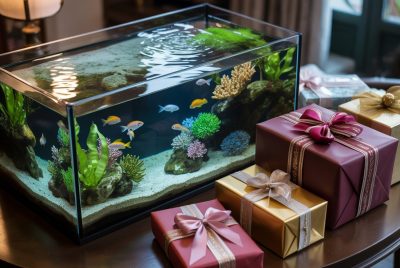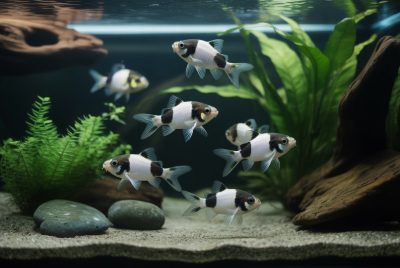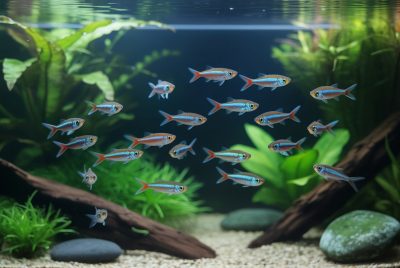Quarantine New Fish Without a Separate Tank
*We may earn a commission for purchases made using our links. Please see our disclosure to learn more.
Adding new fish to an established aquarium can be one of the most exciting moments for any aquarist. However, the traditional advice of using a separate quarantine tank often feels overwhelming for beginners or those with limited space and budget. The reality is that not every fish enthusiast has room for multiple tanks, and the cost of setting up a proper quarantine system can be prohibitive.
This comprehensive guide explores innovative methods to safely introduce new fish to your aquarium without the need for a separate quarantine tank. These techniques have been developed through years of practical experience and successful fish introductions, proving that responsible fishkeeping doesn’t always require expensive equipment or extensive space.
“The key to successful fishkeeping isn’t just about the equipment you have, but understanding the creative solutions that work within your constraints.”
– Marine Biology Research Institute
Key Takeaways
- In-tank quarantine methods can be equally effective when executed properly
- Visual inspection and behavioral monitoring are crucial for early disease detection
- Gradual acclimation techniques reduce stress and improve survival rates
- Water quality management becomes even more critical during the introduction process
- Emergency protocols should always be in place before introducing new fish
Recommended Products Available on Amazon
1. API Stress Coat Water Conditioner
Make fish quarantine easier and safer with API STRESS COAT Aquarium Water Conditioner. Designed for fishkeepers who want to quarantine new fish without a separate tank, this aloe vera-based treatment instantly detoxifies tap water and protects fish with a healing slime coat. Whether you're introducing new fish, treating injuries, or doing routine maintenance, API STRESS COAT reduces stress and boosts immunity—perfect for community tanks without extra quarantine setups.
- Stress Relief Support: Reduces fish stress during transport, acclimation, or tank introduction.
- Healing Formula: Aloe vera promotes slime coat regeneration and helps recovery from minor injuries.
- Versatile Use: Ideal for water changes, new additions, or fish that look stressed—no extra tank needed.
- Short-Term Solution: Not a substitute for full medical quarantine if disease is present.
- Can Cloud Water: Overdosing may cause temporary cloudiness in some tanks.
- No Disease Treatment: Does not treat infections—use with medications when needed.
Essential for neutralizing harmful chemicals and providing a protective slime coat for new fish during the acclimation process. This product reduces stress and helps fish adapt to their new environment more quickly.
2. Seachem Prime Water Conditioner
Seachem Prime is a powerful, concentrated water conditioner that ensures your betta fish thrives in a clean and safe environment. This 500 mL bottle treats up to 5,000 gallons of water, making it both effective and economical. It instantly removes chlorine and chloramine, and detoxifies ammonia, nitrite, and heavy metals, allowing your aquarium's biofilter to work more efficiently. Whether you're performing a water change or setting up a new tank, Prime provides immediate protection, creating a stress-free habitat for your betta.
- Highly Concentrated: A little goes a long way—500 mL treats up to 5,000 gallons.
- Broad Protection: Neutralizes chlorine, chloramine, ammonia, nitrite, and heavy metals.
- Emergency Use: Can be safely dosed up to 5x in urgent situations.
- Strong Odor: Has a noticeable sulfur smell some users find unpleasant.
- Precise Dosing Needed: Overdosing can cause confusion without proper measuring.
- No Built-in Dropper: Requires separate tool or care for small tank dosing.
A concentrated formula that detoxifies ammonia, nitrites, and nitrates while providing essential electrolytes. Perfect for emergency water changes and maintaining water quality during fish introductions.
3. Fluval Multi-Chamber Holding & Breeding Box
The Fluval Multi-Chamber Holding and Breeding Box offers a smart, space-saving solution to quarantine new fish without a separate tank. This clear, hang-on breeding box attaches easily to the outside of your main aquarium, circulating water using an air pump (sold separately). Whether you're isolating new arrivals, protecting fry, or acclimating delicate fish, it provides a secure environment without disrupting your established tank setup.
- Space-Saving Design: Hangs externally to save space inside your main aquarium.
- Multi-Use Functionality: Great for breeding, acclimating, or isolating sick or aggressive fish.
- Water Circulation Ready: Maintains water quality using shared filtration from your main tank (with air pump).
- Requires Air Pump: Water flow depends on a separate air pump (not included).
- Limited Space: Small volume (0.3 gallons) is best for short-term isolation only.
- Plastic Build: Not as sturdy as a glass quarantine tank for long-term use.
Creates a temporary isolation space within your main tank, allowing new fish to acclimate while remaining separated from established tank inhabitants. Ideal for observation and initial quarantine periods.
4. API Quick Start Nitrifying Bacteria
When you quarantine new fish without a separate tank, maintaining stable water conditions is critical—API QUICK START Nitrifying Bacteria makes that easier. This powerful formula instantly adds beneficial bacteria to establish or reinforce your tank’s biological filtration, preventing ammonia and nitrite spikes that stress or kill fish. Ideal for both freshwater and saltwater setups, it's especially useful when adding new fish or changing media, keeping your main tank safe during in-tank quarantine.
- Instant Bio Support: Quickly establishes bacteria to neutralize ammonia and nitrites.
- Safe for Immediate Stocking: Allows safe fish introduction to new or uncycled tanks.
- Fresh & Saltwater Compatible: Works in both freshwater and marine environments.
- No Visible Effect: Results aren’t always immediately noticeable—requires trust in the process.
- Not a Water Conditioner: Should be paired with a dechlorinator like API Stress Coat.
- Routine Use Recommended: Best results when used regularly, not just once.
Accelerates the establishment of beneficial bacteria in your aquarium, crucial when bioload increases with new fish additions. Helps maintain stable water parameters during the introduction process.
Understanding In-Tank Quarantine Methods
The Observation Period Approach
The foundation of successful in-tank quarantine begins before the fish ever enters your aquarium. This method relies heavily on careful observation and preparation rather than physical separation.
Visual Health Assessment
Before purchasing new fish, spend considerable time observing them at the store. Look for clear eyes, intact fins, active swimming behavior, and healthy appetite. Fish that hide constantly, swim erratically, or show visible signs of disease should be avoided entirely.
Water Parameter Matching
Test both your home aquarium water and the store’s water parameters. Gradually adjust your tank’s conditions over several days to match the store’s parameters, then slowly transition back to your preferred levels after introduction.
The Gradual Introduction Method
This technique involves introducing new fish during optimal conditions when your established fish are less likely to be aggressive and when you can monitor the situation closely.
Timing Considerations
Introduce new fish during feeding time when established fish are distracted, or just before lights-out when fish are naturally less active. This reduces initial stress and aggressive encounters.
Behavioral Monitoring
Watch for signs of stress, disease, or incompatibility during the first 48-72 hours. New fish should begin eating within 24-48 hours and show normal swimming patterns within the first week.
Creating Safe Zones Within Your Aquarium
Temporary Barriers and Hiding Spots
Transform your existing aquarium into a safer environment for new arrivals by creating designated areas that provide security and reduce territorial disputes.
Strategic Decoration Placement
Rearrange decorations to create new territories and break up established territorial boundaries. Add temporary hiding spots like caves, plants, or decorations that can be removed once the fish are established.
Lighting Modifications
Dim the aquarium lights for the first few days to reduce stress and allow fish to acclimate more gradually. Bright lights can increase anxiety in newly introduced fish.
Water Quality Management
Maintaining exceptional water quality becomes even more critical when bypassing traditional quarantine methods.
Increased Water Change Frequency
Implement daily 10-15% water changes for the first week after introduction. This helps remove stress hormones, maintains stable parameters, and dilutes any potential pathogens.
Enhanced Filtration
Temporarily increase filtration capacity by adding a secondary filter or increasing flow rates. This helps process the increased bioload and maintains water clarity.
Emergency Protocols and Backup Plans
Disease Detection and Response
Without a separate quarantine tank, early detection and rapid response become absolutely critical.
Daily Health Checks
Establish a routine of observing each fish for at least 5 minutes twice daily. Look for changes in behavior, appetite, swimming patterns, or physical appearance.
Immediate Isolation Options
Keep a hospital tank setup ready for emergency use, or maintain a floating breeder box for immediate isolation if problems arise. These tools should be easily accessible and ready for immediate deployment.
Treatment Strategies
Preventive Medications
Consider using broad-spectrum preventive treatments that are safe for all fish species in your tank. However, research compatibility carefully and never medicate without understanding potential interactions.
Natural Immune Boosters
Enhance fish immunity through high-quality foods, stress reduction, and optimal water conditions rather than relying solely on medications.
Common Challenges and Solutions
Aggression Management
Feeding Distractions
Provide multiple feeding stations and increase feeding frequency during the first week to reduce competition and territorial behavior.
Tank Rearrangement
Completely rearrange decorations when adding new fish to reset territorial boundaries and create equal opportunities for all fish to establish new territories.
Stress Reduction Techniques
Environmental Stability
Maintain consistent temperature, lighting schedules, and feeding routines to minimize additional stressors during the adaptation period.
Chemical Stress Reducers
Use water conditioners with stress-reducing additives, but avoid over-treatment which can cause additional problems.
Monitoring and Long-Term Success
Establishing Healthy Routines
Documentation System
Keep detailed records of fish behavior, feeding responses, and any changes in appearance or activity levels. This information becomes invaluable for identifying problems early.
Regular Health Assessments
Continue intensive monitoring for at least 2-3 weeks after introduction, gradually returning to normal observation routines once fish are fully established.
Building Community Harmony
Gradual Integration
Allow established fish to accept newcomers gradually rather than forcing interactions. Patience during this process leads to more harmonious long-term relationships.
Feeding Hierarchy
Understand and work with natural feeding hierarchies rather than fighting them. Ensure all fish receive adequate nutrition without creating excessive competition.
Advanced Techniques for Experienced Aquarists
Biological Preparedness
Beneficial Bacteria Supplementation
Boost biological filtration capacity before introducing new fish by adding bacterial supplements and increasing surface area for beneficial bacteria growth.
Immune System Support
Prepare existing fish for new arrivals by enhancing their immune systems through varied diets, optimal water conditions, and stress reduction.
Environmental Manipulation
Seasonal Timing
Time fish introductions to coincide with natural breeding seasons when fish are more tolerant of newcomers and less likely to exhibit extreme territorial behavior.
Water Chemistry Optimization
Fine-tune water parameters to create optimal conditions for both new and established fish, potentially using species-specific requirements as guidelines.
Conclusion
Successfully quarantining new fish without a separate tank requires dedication, preparation, and vigilant monitoring, but it’s entirely achievable with the right approach. The key lies in understanding that quarantine isn’t just about physical separation, it’s about creating safe conditions for successful integration while maintaining the health of your entire aquarium ecosystem.
Remember that every aquarium is unique, and what works for one setup may require modification for another. Start with these fundamental principles, adapt them to your specific situation, and always prioritize the health and safety of all your aquatic companions. With patience and proper technique, you can successfully introduce new fish to your aquarium while maintaining a healthy, thriving community.
The journey of fishkeeping is one of continuous learning and adaptation. By mastering these in-tank quarantine methods, you’re not just saving space and money, you’re developing a deeper understanding of fish behavior, water chemistry, and aquarium management that will serve you well throughout your fishkeeping journey.
Frequently Asked Questions
Q1: How long should I monitor new fish when using in-tank quarantine methods?
A: Intensive monitoring should continue for at least 2-3 weeks after introduction. Daily observation for the first week is crucial, followed by twice-daily checks for the second week. After three weeks, you can return to normal observation routines while remaining alert for any changes.
Q2: What are the most important signs to watch for when introducing new fish without quarantine?
A: Key warning signs include rapid breathing, clamped fins, loss of appetite, unusual swimming patterns, visible spots or lesions, and excessive hiding. Additionally, watch for aggressive behavior from established fish and signs of stress in both new and existing inhabitants.
Q3: Can I use medications in my main tank as a preventive measure?
A: While some aquarists use broad-spectrum medications preventively, this approach carries risks including beneficial bacteria disruption, medication resistance, and potential harm to sensitive species. It’s generally safer to focus on optimal water conditions and natural immune support unless specific diseases are detected.
Q4: What should I do if a new fish shows signs of illness after being added to my main tank?
A: Immediately isolate the sick fish using a hospital tank or floating breeder box. Increase water changes in the main tank, monitor all other fish closely, and consider consulting with experienced aquarists or veterinarians for treatment options. Never delay action when disease is suspected.
Q5: Is it safe to add multiple new fish at once using these methods?
A: Adding multiple fish simultaneously increases risk significantly and is generally not recommended for beginners. If you must add multiple fish, do so gradually over several weeks, ensure your filtration can handle the increased bioload, and be prepared for more intensive monitoring and potential emergency interventions.
















